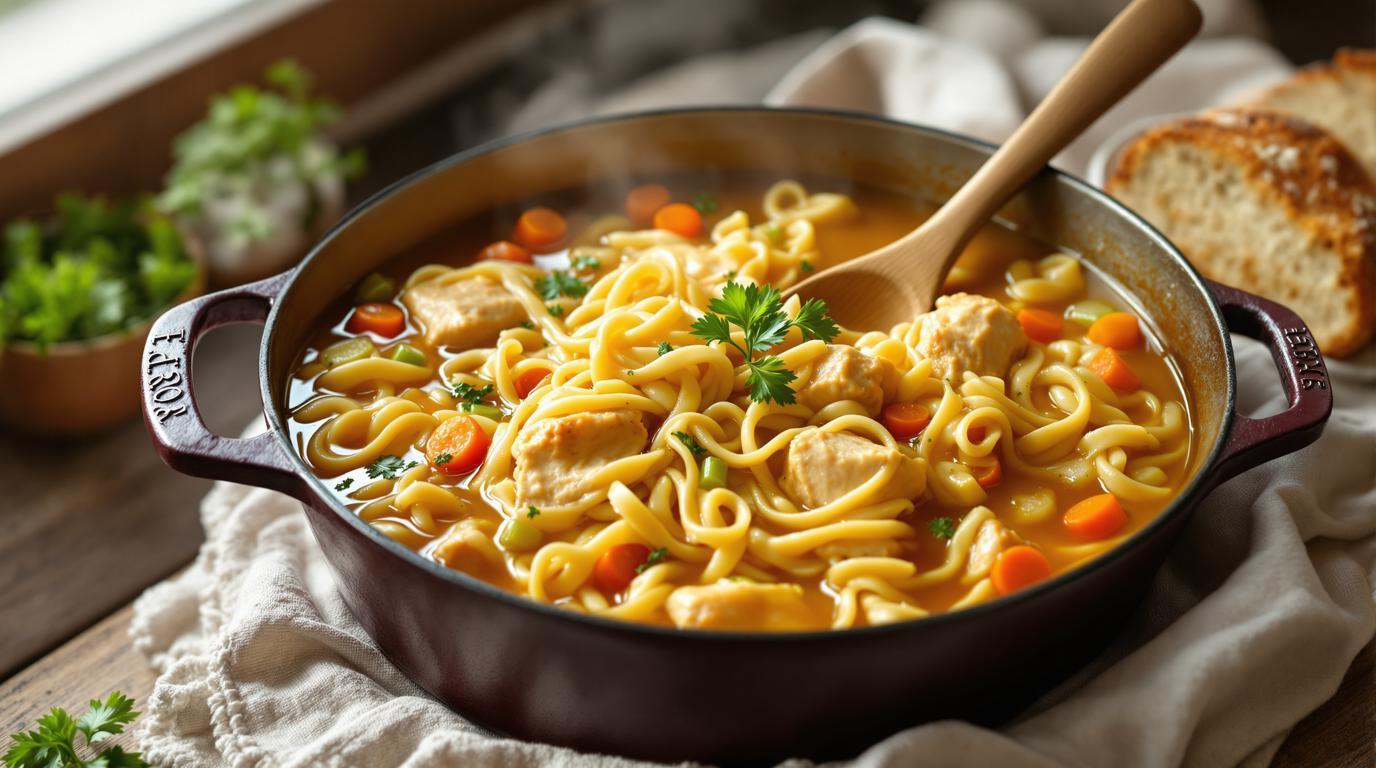There’s something almost magical about a pot of chicken and noodles simmering on the stove. Growing up in my grandmother’s Michigan farmhouse, this dish was our Sunday afternoon ritual. The kitchen windows would fog as the broth bubbled away, carrying aromas that seemed to reach every corner of the house. It wasn’t until I attended culinary school that I realized this humble dish – what I considered simply “grandma food” – carried cooking wisdom that rivaled the most sophisticated French techniques. Today, I’m sharing my perfected version that honors those traditions while ensuring foolproof results in your kitchen.
The Story Behind Traditional Chicken and Noodles 📖
This comforting dish sits somewhere between a hearty soup and a stew, with roots stretching across America’s heartland. Unlike its cousin chicken noodle soup, traditional chicken and noodles features a thicker, more substantial consistency with a higher noodle-to-broth ratio. While researching regional American cuisine during my early career, I discovered families across the Midwest and South had their own slight variations – some using homemade pastry techniques for the noodles, others preferring thicker dumpling-style additions.
What makes this dish truly special is how it showcases the beauty of slow cooking – drawing deep flavor from simple ingredients through gentle, patient cooking. The magic happens in the marriage of tender chicken, aromatic vegetables, and those wonderful egg noodles that absorb just enough broth to become silky and flavorful.
Essential Ingredients 🧾
- 2½ pounds bone-in chicken thighs (or 2 pounds boneless thighs)
- 1 large yellow onion, diced (about 1½ cups)
- 3 medium carrots, peeled and sliced into ¼-inch coins (about 1 cup)
- 2 celery stalks, sliced (about ¾ cup)
- 3 garlic cloves, minced
- 2 bay leaves
- 1 teaspoon dried thyme (or 1 tablespoon fresh)
- 6 cups low-sodium chicken broth
- 8 ounces wide egg noodles
- ¼ cup fresh parsley, chopped
- 2 tablespoons unsalted butter
- 2 tablespoons all-purpose flour (optional, for thickening)
- Salt and freshly ground black pepper, to taste
Step-by-Step Instructions 📝
- Develop the flavor base: In a large Dutch oven or heavy-bottomed pot, heat 2 tablespoons of olive oil over medium heat. Season the chicken pieces generously with salt and pepper. Working in batches if necessary, brown the chicken skin-side down until golden, about 5-6 minutes, then flip and cook 2 minutes more. Transfer to a plate.
- Create the aromatic foundation: In the same pot, add the onions, carrots, and celery, cooking until softened but not browned, about 5-7 minutes. Add the garlic and cook until fragrant, about 30 seconds. Similar to how traditional Scottish porridge builds flavor from simple ingredients, each layer here creates depth.
- Simmer to tenderness: Return the chicken to the pot. Add thyme, bay leaves, and chicken broth. Bring to a gentle boil, then reduce heat to maintain a simmer. Cover partially and cook for 25-30 minutes, until chicken is very tender.
- Prepare the chicken: Remove chicken pieces to a cutting board. When cool enough to handle, shred the meat, discarding skin and bones. Meanwhile, bring the broth back to a simmer.
- Optional thickening step: For a creamier, more stew-like consistency, melt butter in a small saucepan and whisk in flour to make a roux. Cook for 1-2 minutes until lightly golden, then whisk this mixture into your simmering broth. This technique mirrors the one I use for creamy sauces, creating body without heaviness.
- Cook the noodles: Add egg noodles directly to the simmering broth. Cook until just tender, about 7-9 minutes (or according to package directions).
- Finish the dish: Return shredded chicken to the pot. Add chopped parsley, taste, and adjust seasoning. Allow to rest 5 minutes before serving – this final rest is crucial for the flavors to marry.
Chef’s Secret Techniques 🤫
Chef’s Note: The key to exceptional chicken and noodles lies in the broth. While store-bought works, making a quick enhanced broth takes only minutes: add chicken wings or backs to your store-bought broth and simmer 20 minutes before straining. This simple step creates remarkable depth without the time commitment of fully homemade stock.
When browning your chicken, patience is crucial. Let it develop a deep golden crust without moving it – this is where foundational flavor begins. Think of it like the technique for perfect roasted potatoes – undisturbed cooking creates the best textures.
Many home cooks add noodles too early and end up with a starchy, mushy mess. If you’re not serving immediately, consider cooking noodles separately in salted water, tossing with a touch of butter, and adding to individual bowls with the hot broth. This prevents the noodles from absorbing too much liquid during storage.
Serving & Presentation Tips 🍽️
Serve this hearty dish in wide, shallow bowls that showcase the beautiful components. I like to drizzle a small amount of extra-virgin olive oil on top, adding richness and a lovely sheen. For texture contrast, offer crusty bread on the side – perfect for soaking up every last bit of the rich broth.
This recipe pairs beautifully with a simple green salad dressed with lemon and olive oil, similar to how traditional eggplant dishes are complemented by bright, acidic notes.
When I serve this at home, I always place small bowls of additional toppings on the table: extra fresh herbs, lemon wedges, and freshly grated Parmesan. This interactive element lets everyone customize their bowl to personal preference.
There’s profound satisfaction in mastering these heritage recipes – dishes that have sustained families for generations. While cooking trends come and go, the simple pleasure of perfectly tender chicken and silky egg noodles in a flavorful broth remains timeless. I hope this dish brings the same comfort to your table as it has to mine for decades.
